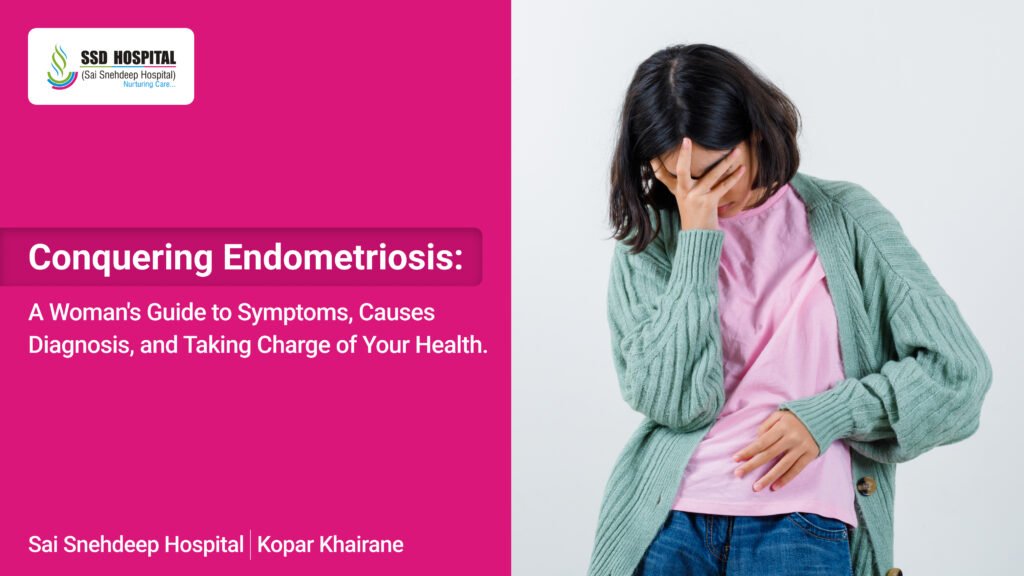Recognizing the Signs: A Guide to Understanding Stroke Symptoms Introduction:A...
Read More- hello@ssdhospital.in
- +91 8989 58 5050

Endometriosis is a common and often very painful condition that affects many women around the world. Despite being quite common, it’s often poorly understood and can be hard to diagnose correctly. In this guide, we want to dive deep into what endometriosis is all about, including its symptoms, possible causes, how doctors diagnose it, and the various treatment options available. Our goal is to help people with endometriosis understand their condition better and help doctors and others in the medical field learn more about managing it effectively.
Endometriosis comes with a range of symptoms, and they can be different for each person. The main one is pelvic pain, which can be there all the time, come and go, or be bad sometimes. Other common symptoms include painful periods, pain during sex, irregular bleeding, tummy troubles, and trouble getting pregnant. These symptoms can affect a person’s life, causing physical discomfort, feeling down, and making it hard to do everyday things
Medical experts are still working to understand the precise reasons behind why endometriosis occurs. There are a few ideas, though. One is called “retrograde menstruation,” where instead of blood leaving the body normally during a period, it flows backward into the pelvis. Other ideas include problems with the immune system, genetics (like family history), and things in the environment. It’s probably a mix of all these things that leads to someone getting endometriosis.
Diagnosing endometriosis can be challenging due to its nonspecific symptoms and lack of definitive diagnostic tests. Healthcare providers often rely on a combination of medical history, symptom assessment, physical examination, and imaging studies to evaluate suspected cases of endometriosis. Transvaginal ultrasound may be used to visualize ovarian endometriomas (endometriotic cysts) or other pelvic abnormalities. However, the gold standard for diagnosing endometriosis is laparoscopic surgery, during which a surgeon can directly visualize and biopsy endometrial implants for confirmation.
The management of endometriosis aims to alleviate symptoms, improve quality of life, and preserve fertility whenever possible. Treatment options for endometriosis may vary depending on the severity of symptoms, the extent of the disease, and the individual’s reproductive goals.
Nonsteroidal anti-inflammatory drugs (NSAIDs) such as ibuprofen or naproxen may be prescribed to alleviate pelvic pain and discomfort associated with endometriosis.
Hormonal therapies are commonly used to suppress menstrual cycles and reduce estrogen levels, thereby inhibiting the growth and proliferation of endometrial tissue outside the uterus. Options include oral contraceptives, progestins, gonadotropin-releasing hormone (GnRH) agonists, and danazol.
Laparoscopic surgery, also known as laparoscopy, is often recommended for both diagnosis and treatment of endometriosis. During laparoscopy, a surgeon can visualize and remove endometrial implants, scar tissue (adhesions), and ovarian cysts (endometriomas). In severe cases of endometriosis, where conservative measures have failed, a hysterectomy (removal of the uterus) with or without removal of the ovaries (oophorectomy) may be considered as a last resort.
For individuals with endometriosis who desire fertility preservation, a multidisciplinary approach involving reproductive endocrinologists, fertility specialists, and gynecologic surgeons may be recommended. Assisted reproductive technologies (ART), such as in vitro fertilization (IVF), may be utilized to improve the chances of conception in individuals with endometriosis-associated infertility.
Complementary and alternative therapies such as acupuncture, chiropractic care, dietary modifications, herbal supplements, and mind-body practices (e.g., yoga, and meditation) are often used as adjunctive treatments to alleviate symptoms and improve overall well-being. While research on the efficacy of these interventions in managing endometriosis is limited, many individuals report subjective benefits and symptom relief.
Endometriosis is a complex and multifaceted condition that requires a comprehensive approach to diagnosis and management. By raising awareness, improving access to care, and advancing research efforts, we can enhance outcomes for individuals affected by endometriosis. Empowering patients with knowledge, support, and personalized treatment options is essential in navigating the challenges posed by this chronic condition and improving quality of life. Let us continue to advocate for better understanding, recognition, and care for those with endometriosis.
Recognizing the Signs: A Guide to Understanding Stroke Symptoms Introduction:A...
Read MoreConquering Endometriosis: A Woman’s Guide to Symptoms, Causes, Diagnosis, and...
Read MoreEndometriosis is a common and often very painful condition that...
Read MoreHIV/AIDS is a formidable health challenge affecting millions worldwide. To...
Read MoreBook your Appointment